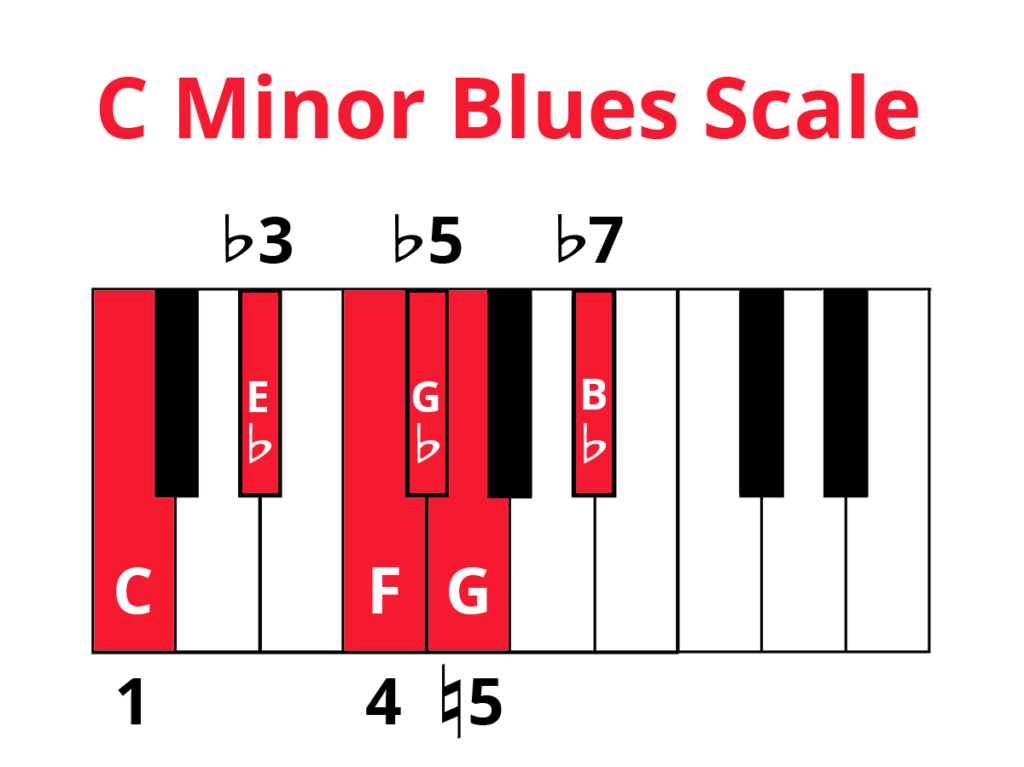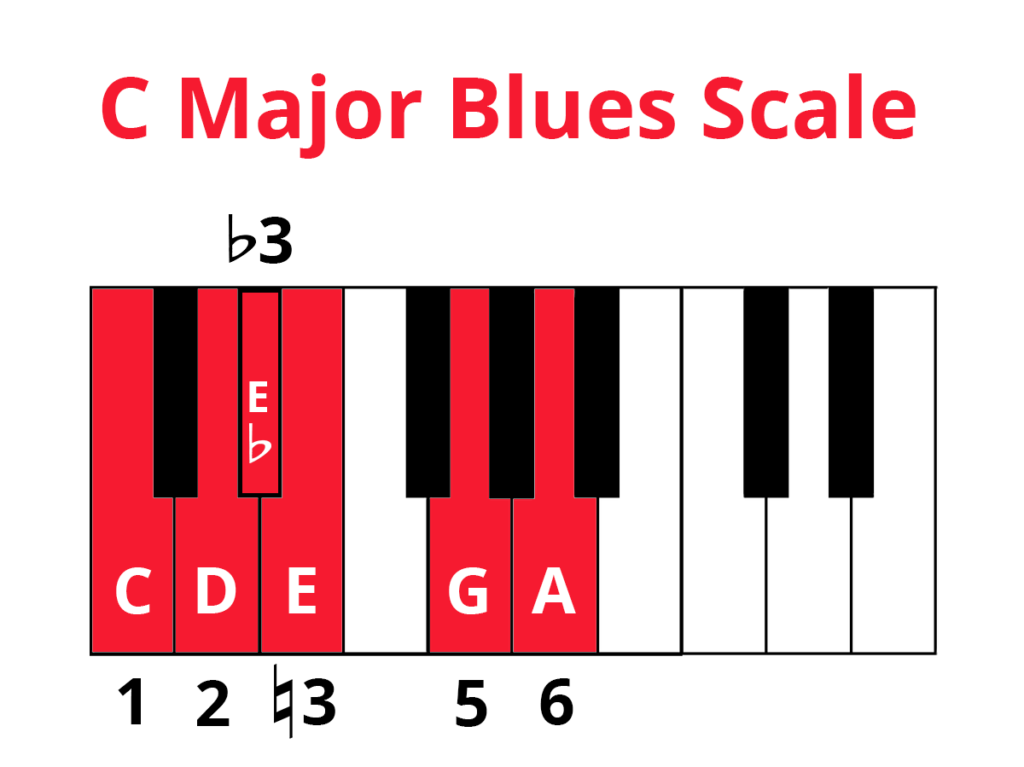The blues scale. On the piano, it’s one of the most popular, versatile, and useful tools to make music. If you want to learn how to play licks, riffs, runs, and improvise, you’ve got to learn the blues scale!
Now, there are different types of blues scales, and individual artists may add or omit notes as they see fit. In this lesson, we’ll discuss the most popular minor and major blues scales. And we’ll also share some tips on how to use this scale in your solos.
Love the Blues? Enter your email and you’ll get 4 FREE Play-along lessons to get you started with this amazing style.
The minor blues scale is THE most popular blues scale. In fact, most of the time, when people talk about the “blues scale,” they’re referring to the minor blues scale.
The formula for the minor blues scale is:
1, ♭3, 4, ♭5, ♮5, ♭7
In C Minor, here’s what this looks like on the piano keyboard:

And here is what the blues scale looks like in standard piano notation:

The minor blues scale formula can be confusing because it’s based on the major scale, not the minor scale. So, if you see “E Minor Blues Scale,” consider the formula in the context of the E Major key signature.
Another thing: “flat” in this context is better understood as “lower by a half-step,” not a literal flat sign.
So, let’s take the notes of the E Major scale:
1 = E
2 = F#
3 = G#
4 = A
5 = B
6 = C#
7 = D#
…and by applying the minor blues formula, we’ll get:
1 = E
♭3 = G♮
4 = A
♭5 = B♭
♮5 = B
♭7 = D♮
If you can play the blues, you can do anything.
Ray Charles
Subscribe to The Note for exclusive interviews, fascinating articles, and inspiring lessons delivered straight to your inbox. Unsubscribe at any time.
The major blues scale is less common, but it’s still a good scale to know. Here’s the formula for it:
1, 2, ♭3, ♮3, 5, 6
Here’s what it looks like on the piano keyboard:

And here’s what it looks like on the staff:

Like the minor blues scale, the formula is based on the major scale. Again, if we use E Major as an example:
1 = E
2 = F#
3 = G#
4 = A
5 = B
6 = C#
7 = D#
…then apply the major blues scale formula, we’ll get:
1 = E
2 = F#
♭3 = G♮
♮3 = G#
5 = B
6 = C#
Once you’re familiar with the basic building blocks of the blues scale, jumpstart your mastery by learning these three essential riffs. You can download a notated PDF of these riffs and more here.



Our PDF download will include both simpler and more complex versions of these riffs.
When you first start improvising with the blues scale, it’s tempting to just go up and down the scale. While this is a great way to familiarize yourself with the notes, it can quickly get bland. Here are some ideas to help you take improvisation to the next level:
Sometimes, we can get anxious about what notes to play and forget about rhythm. But rhythm can be the difference between an okay solo and a fantastic one. So take a look at your solos: are you playing in all quarter notes? Can you add an extra triplet in there, or maybe hold out a whole note? Rhythmic variations keep things interesting!
You don’t have to use all the notes in the blue scale. Try limiting yourself to a small area of notes and see what you can create from that small palette. You may be surprised!
Learning to improvise is all about building vocabulary. If you find a lick that works, practice it in all 12 keys so that you can throw it into any song. Then, keep expanding your vocabulary!
Thinking, “I need to come up with a solo that lasts dozens of bars!” can feel overwhelming. Instead, think in short, small chunks that are only a few measures long.
Practicing with a backing track will help you stay in tempo and let you focus on improvising melodic lines without worrying too much about comping. You can find backing tracks downloadable online and on YouTube.
More lessons you might like:
And if you want more support, including personalized support, consider joining Pianote as a Member 🙂
As a Pianote+ Member, you’ll get access to our 10-step Method, song library, and growing community of piano players just like you. Plus: get coached by world-class pianists who have played with rock stars.
Pianote is the Ultimate Online Piano Lessons Experience™. Learn at your own pace, get expert lessons from real teachers and world-class pianists, and join a community of supportive piano players. Learn more about becoming a Member.
/marketing/pianote/lead-gen/digital-chords-and-scales/master-every-chord-bg.png)
/marketing/pianote/lead-gen/digital-chords-and-scales/Chords-scales-digital-logo.png)
Enter your email address to get your FREE E-Book instantly.
By signing up you'll also receive our ongoing free lessons and special offers. Don't worry, we value your privacy and you can unsubscribe at any time.
We use cookies for traffic data and advertising. Cookie Policy »